Passage-1
The conversion of an amide by action of NaOHandBr2 to primary amine that has one carbon less than the starting amide is known as Hofmann-Bromoamide reaction.
R−C−NH2Br2+NaOH−−−−−−−−−→orNaOBrR−NH2+NaBr+Na2CO3
Mechanism:
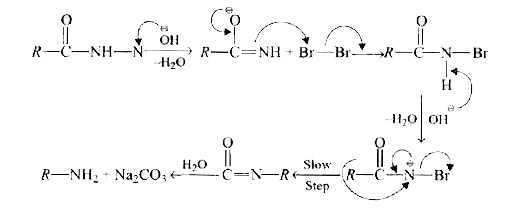
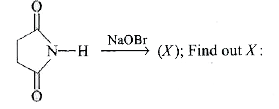
Find out X:

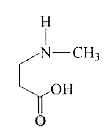

All of these
The correct Answer is:A
Step by step video & image solution for Passage-1 The conversion of an amide by action of NaOH and Br_2 to primary amine that has one carbon less than the starting amide is known as Hofmann-Bromoamide reaction. R - C - NH_2 underset("or" NaOBr) overset(Br_2 + NaOH) (to) R - NH_(2) + NaBr + Na_(2) CO_(3) Mechanism: Find out X: by Chemistry experts to help you in doubts & scoring excellent marks in Class 12 exams.
Updated on:21/07/2023Similar Questions
When acetamide is treated with Br2 and an alkali, a primary amine containing one carbon atom less than the starting amide is formed. Name the reaction and write the balanced equation.
View SolutionHoffmann bromamide reaction involves conversion of a carboxylic acid amide into an amine with a loss of a carbon atom on treatment with aqueous sodium hypobromite. Thus Hoffmann result in shortening of a carbon chain.
R−O∣∣C−NH2Br2−−−→NaOHR−NH2+NaBr+Na2CO3
Mechanism of the reaction is :
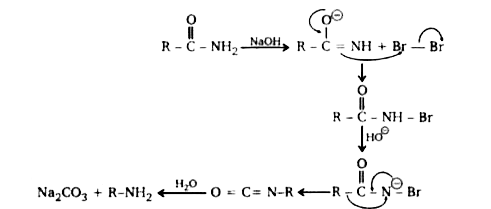
 Product (A) is :
Product (A) is :
View Solution
Knowledge Check
Hoffmann bromamide reaction involves conversion of a carboxylic acid amide into an amine with a loss of a carbon atom on treatment with aqueous sodium hypobromite. Thus Hoffmann result in shortening of a carbon chain.
R−O∣∣C−NH2Br2−−−→NaOHR−NH2+NaBr+Na2CO3
Mechanism of the reaction is :
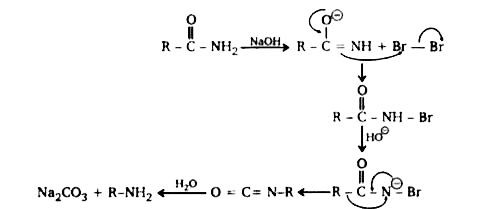
Number of moles of NaOH consumed in above reaction.A1B2C3D4Hoffmann bromamide reaction involves conversion of a carboxylic acid amide into an amine with a loss of a carbon atom on treatment with aqueous sodium hypobromite. Thus Hoffmann result in shortening of a carbon chain.
R−O∣∣C−NH2Br2−−−→NaOHR−NH2+NaBr+Na2CO3
Mechanism of the reaction is :
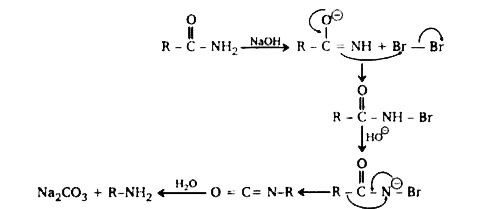
Which of the following will not give Hoffmann bromamide reaction.ACH3−O∣∣C−NH2B C
C D
D
Hoffmann bromamide reaction involves conversion of a carboxylic acid amide into an amine with a loss of a carbon atom on treatment with aqueous sodium hypobromite. Thus Hoffmann result in shortening of a carbon chain.
R−O∣∣C−NH2Br2−−−→NaOHR−NH2+NaBr+Na2CO3
Mechanism of the reaction is :

 Product (A) : APh−NH2BPh−CH2−NH2CPh−NH−CH3D
Product (A) : APh−NH2BPh−CH2−NH2CPh−NH−CH3D
In Hofmann bromamide degradation reaction
R−O∣∣C−NH2+KOH+Br2→
intermediates are:
View SolutionIn the reaction Me–C≡C−EtNa/lig.NH3−−−−−−−→PBr2−−→CCl4(Q), then Q is :
View SolutionProduct C in the reaction
C2H5BrNaOH−−−−−→(aqueous)ANa−−→BCH3I−−→C will be
View SolutionIn the given reaction sequence C6H5−CH2−NH2CHCl3/Alc.KOH−−−−−−−−−−−−−→Δ[X]H2O/NaOH−−−−−−−→[Y].
[Y] will be:
View SolutionRCOOAg+Br2CCl4−−−−−→ΔR−Br+AgBr+CO2 . This reaction is called :
View Solution
